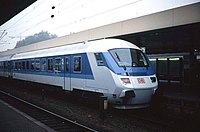User:ArtVandelay13/IR
 A DB InterRegio train at Heidelberg | |
| Overview | |
|---|---|
| Locale | Germany |
| Dates of operation | 1988–2004 |
| Predecessor | D-Zug |
| Successor | Various (see below) |
| Technical | |
| Track gauge | 1,435 mm (4 ft 8+1⁄2 in) |
| Other | |
| Website | www.bahn.com |
The InterRegio (IR) train classification in Germany operated between 1988 and 2006 for secondary express trains - slower than Intercity but faster than Regional services. InterRegio replaced the former D-Zug classification, providing services throughout Germany, generally on a two hour frequency. The trains were locomotive-hauled, with specially modernised coaches in a distinctive light blue livery. The services were very well received by passengers, but some services struggled for passenger numbers, and on the whole InterRegio was a loss-making enterprise for Deutsche Bahn. This, combined with the growth of the ICE network, caused DB to discontinue the services in 2002, although a few routes remained for a few years. Many former-IR services are now classed as Intercity, while others have been abandonded altogether, leaving many routes, and cities without long-distance services. In some cases, private train operating companies, or the local DB Regio sector have provided replacements for former-InterRegio services.
History[edit]
Conception[edit]

Following the development of the Intercity network in the 1980s, the Deutsche Bundesbahn needed to raise money, and in doing so, make the D-Zug class of secondary express trains more profitable. A new brand of train was planned, known as XD-Zug in planning, but later to be named InterRegio. The idea was for a "train for the well-being", a network of services with two hourly frequency, formed of modernised coaches and including an on-board bistro. Routes were designed around an average journey length of 150km, with an average speed of 90 km/h, and an average distance between stops of 30km.
The first IR route was introduced in 1988, between Hamburg and Kassel, and extended to Konstanz a year later. The service was heavily marketed, with the slogan "Die neuen Verbindungen im 2-Stunden-Takt" (the new connection every two hours). The network continued to grow into the 1990s, and after the reunification of Germany, many routes spread into the former East.
Peak period[edit]
By the mid-1990s there were over 20 Interegio routes, covering the length and breadth of Germany, with services extending into Denmark (Padborg), Sweden (Malmö), Poland (Olsztyn and Wroclaw), the Czech Republic (Prague), Austria (Bregenz), France (Strasbourg), Luxembourg, and the Netherlands (Amsterdam). By this point, the IR network served 320 stations in Germany, compared with 80 served by the IC/ICE network.
Decline and end[edit]
Towards the end of the 1990s, Deutsche Bahn began to consider withdrawing unprofitable InterRegio routes, to be replaced with state-funded regional service. Certain routes were increasingly lightly loaded; while IR trains were often crowded in urban areas, they were often virtually empty at the extremity of their route. In July 1998, DB announced plans to cancel around half InterRegio routes, and in May 1999 the first phase of this was completed, with 30 IR services withdrawn, including the entirety of line 17 (Aachen to Leipzig). Critics saw this as an attempt by DB to increase popularity of the IC and ICE services.
In autumn 2000, further cuts to the IR network were proposed. Many routes saw a reduced service, with local states stepping in in some cases to subsidise IR services, or modernised Regional-Express services by way of replacement.
Services[edit]
Notes[edit]
References[edit]
- Bodack, Karl-Dieter (2005). InterRegio - Die abenteuerliche Geschichte eines beliebten Zugsystems (in German). Eisenbahn Kurier. ISBN 3882551496.
{{cite book}}: Cite has empty unknown parameters:|lastn=and|firstn=(help); Unknown parameter|trans_title=ignored (|trans-title=suggested) (help)
